Submitted:
21 June 2024
Posted:
24 June 2024
You are already at the latest version
Abstract
Keywords:
Highlights
- Climate change by negatively alters crop performance and cultivation areas
- Excessive use of mineral fertilizers and pesticides contribute to climate change
- Nanotechnology may be a solution in climate change mitigation in agriculture
- Nano-fertilizers deliver nutrients more efficiently, reducing negative effects
- Nano pesticides by reducing doses are more efficient in combating pests and weeds
1. Introduction
| Botanical family | Plant involved | Nanoparticle | Function | Reference |
|---|---|---|---|---|
| Asteraceae | Helianthus annuus | Si NPs | Head diameter and grain yield enhanced, greater content of oleic acid and linoleic acid compared to the control | Ernst et al., 2023 |
| ZnO NPs | ||||
| Lactuca sativa | ZnO NPs | Biomass, chlorophyll, phenolics, flavonoids, and vitamin C increase | Garza-Alonso et al., 2023 | |
| Brassicaceae | Brassica napus | CeO2 NPs | Higher biomass and reduced stress conditions in an salinity-affected environment | Rossi et al., 2016 |
| Cucurbitaceae | Cucumis sativus | CeO2 NPs | Root biomass, Vitamin C and soluble sugar content enhanced, biotransformation of the rhizosphere | Xie et al., 2022 |
| Fabaceae | Glycine max | FeNPs | Number of root nodules boosted and nitrogen-fixing activity increased | Kots et al., 2024 |
| GeNPs | ||||
| CoNPs | ||||
| Medicago sativa | TiO2 | Stomata opening, antioxidant system, plant height, fresh weight increased | Chen et al., 2024 | |
| Poaceae | Oryza sativa | ZnO NPs | Shoot lenght, root lenght and amylase activity improved under cadmium stress | Li et al., 2021 |
| Triticum aestivum | CuO NPs | Plant height, spike lenght, grain and straw yield increased, pigments content enhanced, stress due to cadmium reduced | Alhaithloul et al., 2023 | |
| CeO2 NPs | Plant conditions improved under cadmium toxicity | Ayub et al., 2023 |
||
| Fe NPs | Plant growth enhanced, pigments content and micronutrients uptake increased under salinity stress | Zia-ur-Rehman et al., 2023 |
||
| Rosaceae | Fragaria ananassa | CeO2 NPs | Yield increase, greater pollen grain numbers and pollen tube elongation, total phenols, Vitamin C and soluble sugar content enhance | Dai et al., 2022 |
| Solanaceae | Solanum lycopersicum | AgNPs | Resistance to abiotic stress enhanced and stress parameters reduced | Narware et al., 2024 |
| ZnO NPs | Foliar spray increases crop growth and zinc uptake | Sun et al., 2023 |
1.1. Climate Change on Fertilization
1.2. Climate Change on Agrochemicals
1.3. Climate Change on Post-Harvest
2. Nanoparticles in Agriculture
2.1. Nanoparticles as Nano-Fertilizers and Biofortificators
2.2. Nanoparticles as a New Strategy in Weed and Pests’ Management
2.3. Nanoparticles, Pre- and Post-Harvest Preservation, Food Quality and Packaging
3. A bibliometric Analysis of Nano-Particles Used in Agriculture for Cope Climate Change
3.1. Preface
3.2. Methodology
3.3. Results and Discussion
3.3.1. The Geographical Distribution of Publications and Top Contributing Organizations
3.3.2. Most Influential Publication
3.3.3. Keywords Analysis
4. Final Remarks and Future Challenges
Acknowledgments
References
- Agredo-Gomez, A.D., Molano-Molano, J.A., Portela-Patiño, M.C., Rodríguez-Páez, J.E., 2024. Use of ZnO nanoparticles as a pesticide: In vitro evaluation of their effect on the phytophagous Puto barberi (mealybug). Nano-Structures and Nano-Objects 37, 101095. [CrossRef]
- Ahmad, W., Nepal, J., Xin, X., He, Z., 2023. Agronomic Zn biofortification through nano ZnO application enhanced growth, photosystem efficiency, Zn and P nutrition in maize. Archives of Agronomy and Soil Science 69, 3328–3344. [CrossRef]
- Akintelu, S.A., Olabemiwo, O.M., Ibrahim, A.O., Oyebamiji, J.O., Oyebamiji, A.K., Olugbeko, S.C., 2023. Biosynthesized nanoparticles as a rescue aid for agricultural sustainability and development. International Nano Letters 13, 15–40. [CrossRef]
- Al-Antary, T.M., Ghidan, A.Y., 2023. Strengths and weaknesses of metal oxide nanoparticles in agriculture, in: Nanometal Oxides in Horticulture and Agronomy. pp. 353–376. [CrossRef]
- Al-Mamun, M.R., Hasan, M.R., Ahommed, M.S., Bacchu, M.S., Ali, M.R., Khan, M.Z.H., 2021. Nanofertilizers towards sustainable agriculture and environment. Environmental Technology & Innovation, 23, 101658. [CrossRef]
- Alejandro, S., Höller, S., Meier, B., Peiter, E., 2020. Manganese in Plants: From Acquisition to Subcellular Allocation. Frontiers in Plant Science. [CrossRef]
- Alipour, M., Saharkhiz, M.J., 2016. Phytotoxic activity and variation in essential oil content and composition of Rosemary (Rosmarinus officinalis L.) during different phenological growth stages. Biocatalysis and Agricultural Biotechnology 7, 271–278. [CrossRef]
- Aluja, M., Birke, A., Ceymann, M., Guillén, L., Arrigoni, E., Baumgartner, D., Pascacio-Villafán, C., Samietz, J., 2014. Agroecosystem resilience to an invasive insect species that could expand its geographical range in response to global climate change. Agriculture, Ecosystems and Environment 186, 54–63. [CrossRef]
- Ameen, F., Alsamhary, K., Alabdullatif, J. A., ALNadhari, S. 2021. A review on metal-based nanoparticles and their toxicity to beneficial soil bacteria and fungi. Ecotoxicology and Environmental Safety, 213, 112027. [CrossRef]
- Amirnia, R., Bayat, M., Tajbakhsh, M., 2014. Effects of nano fertilizer application and maternal corm weight on flowering at some saffron (Crocus sativus L.) ecotypes. Turkish Journal of Field Crops, 19(2), 158-168. [CrossRef]
- Amna, Alharby, H.F., Hakeem, K.R., Qureshi, M.I., 2019. Weed Control Through Herbicide-Loaded Nanoparticles, in: Nanomaterials and Plant Potential. pp. 507–527. [CrossRef]
- Anwar, M.P., Islam, A.K.M.M., Yeasmin, S., Rashid, M.H., Juraimi, A.S., Ahmed, S., Shrestha, A., 2021. Weeds and their responses to management efforts in a changing climate. Agronomy. [CrossRef]
- Asadishad, B., Chahal, S., Akbari, A., Cianciarelli, V., Azodi, M., Ghoshal, S., Tufenkji, N. 2018. Amendment of agricultural soil with metal nanoparticles: Effects on soil enzyme activity and microbial community composition. Environmental science & technology, 52(4), 1908-1918. [CrossRef]
- Avellan, A., Yun, J., Morais, B.P., Clement, E.T., Rodrigues, S.M., Lowry, G. V., 2021. Critical Review: Role of Inorganic Nanoparticle Properties on Their Foliar Uptake and in Planta Translocation. Environmental Science and Technology. [CrossRef]
- Badiee, F., Selahvarzi, Y., Abedi, B., Sayyad-Amin, P., 2023. Effect of Deficit Irrigation and Hand Thinning on Post-harvest Quality of Apple Cv. ‘Golab.’ Erwerbs-Obstbau 65, 435–442. [CrossRef]
- Bahrulolum, H., Nooraei, S., Javanshir, N., Tarrahimofrad, H., Mirbagheri, V.S., Easton, A.J., Ahmadian, G., 2021. Green synthesis of metal nanoparticles using microorganisms and their application in the agrifood sector. Journal of Nanobiotechnology. [CrossRef]
- Bajpai, V.K., Kamle, M., Shukla, S., Mahato, D.K., Chandra, P., Hwang, S.K., Kumar, P., Huh, Y.S., Han, Y.K., 2018. Prospects of using nanotechnology for food preservation, safety, and security. J. Food Drug Anal., 26, pp. 1201-1214. [CrossRef]
- Bai, C., 2006. The Advancement of Nanoscience and Nanotechnology in China, in: Science Progress in China. pp. 175–188. [CrossRef]
- Bailey, S.W., 2004. Climate change and decreasing herbicide persistence, in: Pest Management Science. pp. 158–162. [CrossRef]
- Bamisaye, A., Adegoke, K.A., Alli, Y.A., Bamidele, M.O., Idowu, M.A., Ogunjinmi, O.E., 2023. Recent advances in nanoemulsion for sustainable development of farm-to-fork systems. Journal of Cleaner Production. [CrossRef]
- Basavegowda, N., Baek, K.H., 2021. Current and future perspectives on the use of nanofertilizers for sustainable agriculture: The case of phosphorus nanofertilizer. 3 Biotech. [CrossRef]
- Bebber, D.P., Ramotowski, M.A.T., Gurr, S.J., 2013. Crop pests and pathogens move polewards in a warming world. Nature Climate Change 3, 985–988. [CrossRef]
- Bhatnagar, S., Mahanta, D.K., Vyas, V., Samal, I., Komal, J., Bhoi, T.K., 2024. Storage Pest Management with Nanopesticides Incorporating Silicon Nanoparticles: A Novel Approach for Sustainable Crop Preservation and Food Security. Silicon. [CrossRef]
- Bhattacharjee, R., Kumar, L., Mukerjee, N., Anand, U., Dhasmana, A., Preetam, S., Bhaumik, S., Sihi, S., Pal, S., Khare, T., Chattopadhyay, S., El-Zahaby, S.A., Alexiou, A., Koshy, E.P., Kumar, V., Malik, S., Dey, A., Proćków, J., 2022. The emergence of metal oxide nanoparticles (NPs) as a phytomedicine: A two-facet role in plant growth, nano-toxicity and anti-phyto-microbial activity. Biomedicine and Pharmacotherapy. [CrossRef]
- Carvalho, L.B., Godoy, I.S., Preisler, A.C., de Freitas Proença, P.L., Saraiva-Santos, T., Verri, W.A., Oliveira, H.C., Dalazen, G., Fraceto, L.F., 2023. Pre-emergence herbicidal efficiency and uptake of atrazine-loaded zein nanoparticles: A sustainable alternative to weed control. Environmental Science: Nano 10, 1629–1643. [CrossRef]
- Chaiwong, N., Rerkasem, B., Pusadee, T., Prom-u-thai, C., 2021. Silicon application improves caryopsis development and yield in rice. Journal of the Science of Food and Agriculture 101, 220–228. [CrossRef]
- Choudhury, P.P., Saha, S., 2020. Dynamics of pesticides under changing climatic scenario. Environmental Monitoring and Assessment. [CrossRef]
- CIEL, 2022. Fossils, Fertilizers, and False Solutions: How Laundering Fossil Fuels in Agrochemicals Puts the Climate and the Planet at Risk.
- Congreves, K.A., Van Eerd, L.L., 2015. Nitrogen cycling and management in intensive horticultural systems. Nutrient Cycling in Agroecosystems. [CrossRef]
- Conti, M.V., Guzzetti, L., Panzeri, D., De Giuseppe, R., Coccetti, P., Labra, M., Cena, H., 2021. Bioactive compounds in legumes: Implications for sustainable nutrition and health in the elderly population. Trends in Food Science and Technology. [CrossRef]
- Cui, X., 2020. Climate change and adaptation in agriculture: Evidence from US cropping patterns. Journal of Environmental Economics and Management 101, 102306. [CrossRef]
- Currie, H.A., Perry, C.C., 2007. Silica in plants: Biological, biochemical and chemical studies. Annals of Botany 100, 1383–1389. [CrossRef]
- Czyżowska A, Barbasz A. 2022. A review: Zinc oxide nanoparticles - friends or enemies? Int J Environ Health Res. Apr;32(4):885-901. [CrossRef]
- Dastogeer, K.M.G., Zahan, M.I., Rhaman, M.S., Sarker, M.S.A., Chakraborty, A., 2022. Microbe-Mediated Thermotolerance in Plants and Pertinent Mechanisms- A Meta-Analysis and Review. Frontiers in Microbiology. [CrossRef]
- Delcour, I., Spanoghe, P., Uyttendaele, M., 2015. Literature review: Impact of climate change on pesticide use. Food Research International. [CrossRef]
- Desprez-Loustau, M.L., Robin, C., Reynaud, G., Déqué, M., Badeau, V., Piou, D., Husson, C., Marçais, B., 2007. Simulating the effects of a climate-change scenario on the geographical range and activity of forest-pathogenic fungi. Canadian Journal of Plant Pathology 29, 101–120. [CrossRef]
- Dimkpa, C. O. (2018). Soil properties influence the response of terrestrial plants to metallic nanoparticles exposure. Current opinion in environmental science & health, 6, 1-8. [CrossRef]
- Dong, J., Han, A., Zhao, Y., Li, H., Yang, Y., Yuan, B., Wang, Y., Liu, R., Yin, X., Du, X., 2023. Smart, degradable, and eco-friendly carboxymethyl cellulose-CaII hydrogel-like networks gated MIL-101(FeIII) nanoherbicides for paraquat delivery. Science of the Total Environment 903, 166424. [CrossRef]
- El-Moneim, D.A., Dawood, M.F.A., Moursi, Y.S., Farghaly, A.A., Afifi, M., Sallam, A., 2021. Positive and negative effects of nanoparticles on agricultural crops. Nanotechnology for Environmental Engineering. [CrossRef]
- EFSA Scientific Committee; Hardy, A. , Benford, D., Halldorsson, T., Jeger, M.J., Knutsen, H.K., More, S., Naegeli, H., Noteborn, H., Ockleford, C., Ricci, A., Rychen, G., Schlatter, J.R., Silano, V., Solecki, R., Turck, D., Younes, M., Chaudhry, Q., Cubadda, F., Gott, D., Oomen, A., Weigel, S., Karamitrou, M., Schoonjans, R., Mortensen, A, 2018. Guidance on risk assessment of the application of nanoscience and nanotechnologies in the food and feed chain: Part 1, human and animal health. EFSA J. Jul 4;16(7):e05327; 40. EFSA Scientific Committee; Hardy, A., Benford, D., Halldorsson, T., Jeger, M.J., Knutsen, H.K., More, S., Naegeli, H., Noteborn, H., Ockleford, C., Ricci, A., Rychen, G., Schlatter, J.R., Silano, V., Solecki, R., Turck, D., Younes, M., Chaudhry, Q., Cubadda, F., Gott, D., Oomen, A., Weigel, S., Karamitrou, M., Schoonjans, R., Mortensen, A, 2018. Guidance on risk assessment of the application of nanoscience and nanotechnologies in the food and feed chain: Part 1, human and animal health. EFSA J. Jul 4;16(7):e05327. [CrossRef]
- EPA, 2012. Overview of Greenhouse Gases. Epa 1.
- Errázuriz-Montanares, I., Maldonado, F., Cañete-Salinas, P., Espinosa, C., Guajardo, J., Vergara, K., Contreras, S., Acevedo-Opazo, C., 2023. Effect of salicylic acid use on the leaf gas exchange response of cherry plants under root anoxia. New Zealand Journal of Crop and Horticultural Science. [CrossRef]
- Evy Alice Abigail, M., 2019. Biochar-based nanocarriers: Fabrication, characterization, and application as 2,4-dichlorophenoxyacetic acid nanoformulation for sustained release. 3 Biotech 9, 1–9. [CrossRef]
- Faiz, H., Khan, O., Ali, I., Hussain, T., Haider, S.T., Siddique, T., Liaquat, M., Noor, A., Khan, R.W., Ashraf, S., Rashid, S., Noreen, A., Asghar, S., Anjum, Q.S., 2024. Foliar application of triacontanol ameliorates heat stress through regulation of the antioxidant defense system and improves yield of eggplant Title in the second language of the article: Amelioration of heat stress in egg plant through application of tri. Brazilian Journal of Biology 84, 1–10. [CrossRef]
- Faizan, M., Bhat, J.A., El-Serehy, H.A., Moustakas, M., Ahmad, P., 2022. Magnesium Oxide Nanoparticles (MgO-NPs) Alleviate Arsenic Toxicity in Soybean by Modulating Photosynthetic Function, Nutrient Uptake and Antioxidant Potential. Metals 12. [CrossRef]
- FAOSTAT, n.d. "Pesticides Trade,” data for total world value of pesticide exports through 2020, last updated July 15, 2022, accessed, Sept. 18, 2022. https://www. fao.org/faostat/en/#data/RT." [WWW Document].
- Field, C.B., Barros, V.R., Dokken, D.J., Mach, K.J., Mastrandrea, M.D., Bilir, T.E., Chatterjee, M., Ebi, K.L., Estrada, Y.O., Genova, R.C., Girma, B., Kissel, E.S., Levy, A.N., MacCracken, S., Mastrandrea, P.R., White, L.L., 2014. Climate change 2014 impacts, adaptation and vulnerability: Part A: Global and sectoral aspects: Working group II contribution to the fifth assessment report of the intergovernmental panel on climate change, Climate Change 2014 Impacts, Adaptation and Vulnerability: Part A: Global and Sectoral Aspects. Cambridge University Press. [CrossRef]
- Finnegan, P.M., Chen, W., 2012. Arsenic toxicity: The effects on plant metabolism. Frontiers in Physiology 3 JUN, 1–18. [CrossRef]
- Gaillet, S., Rouanet, J.M., 2015. Silver nanoparticles: Their potential toxic effects after oral exposure and underlying mechanisms--a review. Food Chem Toxicol. Mar;77:58-63. [CrossRef]
- Gao, X., Lowry, G.V. 2018. Progress towards the standardized and validated characterizations for measuring physicochemical properties of manufactured nanomaterials relevant to nano health and safety risks. NanoImpact 9: P. 14-30. [CrossRef]
- Ghani, M.I., Saleem, S., Rather, S.A., Rehmani, M.S., Alamri, S., Rajput, V.D., Kalaji, H.M., Saleem, N., Sial, T.A., Liu, M., 2022. Foliar application of zinc oxide nanoparticles: An effective strategy to mitigate drought stress in cucumber seedling by modulating antioxidant defense system and osmolytes accumulation. Chemosphere 289, 133202. [CrossRef]
- Ghidan, A.Y., Al-Antary, T.M., Salem, N.M., Awwad, A.M., 2017. Facile Green Synthetic Route to the Zinc Oxide (ZnONPs) Nanoparticles: Effect on Green Peach Aphid and Antibacterial Activity. Journal of Agricultural Science 9, 131. [CrossRef]
- Ghormade, V., Deshpande, M. V., Paknikar, K.M., 2011. Perspectives for nano-biotechnology enabled protection and nutrition of plants. Biotechnology Advances. [CrossRef]
- Gilbertson, L.M., Pourzahedi, L., Laughton, S., Gao, X., Zimmerman, J.B., Theis, T.L., Westerhoff, P., Lowry, G. V., 2020. Guiding the design space for nanotechnology to advance sustainable crop production. Nature Nanotechnology 15, 801–810. [CrossRef]
- Gong, C., Hasnain, A., Wang, Q., Liu, D., Xu, Z., Zhan, X., Liu, X., Pu, J., Sun, M., Wang, X., 2023. Eco-friendly deacetylated chitosan base siRNA biological-nanopesticide loading cyromazine for efficiently controlling Spodoptera frugiperda. International Journal of Biological Macromolecules 241. [CrossRef]
- González-Curbelo, M.Á., Kabak, B., 2023. Occurrence of Mycotoxins in Dried Fruits Worldwide, with a Focus on Aflatoxins and Ochratoxin A: A Review. Toxins. [CrossRef]
- Granado-Rodríguez, S., Maestro-Gaitán, I., Matías, J., Rodríguez, M.J., Calvo, P., Hernández, L.E., Bolaños, L., Reguera, M., 2022. Changes in nutritional quality-related traits of quinoa seeds under different storage conditions. Frontiers in Nutrition 9, 995250. [CrossRef]
- Guo, H., Wan, S., Ge, F., 2017. Effect of elevated CO2 and O3 on phytohormone-mediated plant resistance to vector insects and insect-borne plant viruses. Science China Life Sciences. [CrossRef]
- Guo, L., Guo, S., Tang, M., Su, M., Li, H., 2022. Financial Support for Agriculture, Chemical Fertilizer Use, and Carbon Emissions from Agricultural Production in China. International Journal of Environmental Research and Public Health 19. [CrossRef]
- Gupta, A.K., Pratiksha, Das, T., Kumar, H., Rastogi, S., Espinosa, E., Rincón, E., Morcillo-Martín, R., Rather, M.A., Kumar, V., Naik, B., Makroo, H.A., Xiao, H.W., Ranjan, R., Mishra, S., 2023. Novel food materials: Fundamentals and applications in sustainable food systems for food processing and safety. Food Bioscience 55, 103013. [CrossRef]
- Guru, T., Thatikunta, R., Reddy, N., 2015. Crop Nutrition Management with Nano fertilizers. International Association of Advances in Research and Development International Journal of Environmental Science and Technology International Journal of Environmental Science and Technology 1, 4–6.
- Hakimovich, H.H., Alishovich, K.B., 2023. View of Assessing the Role of Climate Change in Desertification Processes. Web of Technology: Multidimensional Research Journal 1, 3–10.
- Hammok, N. and Saeed, L.I., 2024. Environmental and Biological Effects of Improper Use of Nano- Fertilizers. The Future of Agriculture 1:62-72. [CrossRef]
- Hanif, S., Sajjad, A., Zia, M., 2023. Proline coated ZnO NPs as nanofertilizer against drought stress: An in vitro study to Coriandrum sativum. Plant Cell, Tissue and Organ Culture 155, 493–504. [CrossRef]
- Hasrin, N.S.A., Shah, N.A., Dzulkifli, N.N., Fatimah, I., Ghazali, S.A.I.S.M., 2023. The Effect of Conventional and Nanoformulation Herbicide on Sphagneticola Trilobata. Trends in Sciences 20, 1–20. [CrossRef]
- Heyl, K., Ekardt, F., Roos, P., Garske, B., 2023. Achieving the nutrient reduction objective of the Farm to Fork Strategy. An assessment of CAP subsidies for precision fertilization and sustainable agricultural practices in Germany. Frontiers in Sustainable Food Systems 7. [CrossRef]
- Hussain, G., Bilal, M., Sultan, M., Miyazaki, T., Mahmood, M.H., Khan, Z.M., 2020. Investigating Applicability of Heat-Driven Desiccant Dehumidification System for Shelf Life Improvement of Fruits and Vegetables, in: International Exchange and Innovation Conference on Engineering and Sciences. Kyushu University, pp. 79–84. [CrossRef]
- Iannone, M.F., Groppa, M.D., de Sousa, M.E., Fernández van Raap, M.B., Benavides, M.P., 2016. Impact of magnetite iron oxide nanoparticles on wheat (Triticum aestivum L.) development: Evaluation of oxidative damage. Environmental and Experimental Botany 131, 77–88. [CrossRef]
- IPCC Working Group 1, I., Stocker, T.F., Qin, D., Plattner, G.-K., Tignor, M., Allen, S.K., Boschung, J., Nauels, A., Xia, Y., Bex, V., Midgley, P.M., 2013. IPCC, 2013: Climate Change 2013: The Physical Science Basis. Contribution of Working Group I to the Fifth Assessment Report of the Intergovernmental Panel on Climate Change. IPCC AR5, 1535.
- Jeger, M.J., Pautasso, M., Holdenrieder, O., Shaw, M.W., 2007. Modelling disease spread and control in networks: Implications for plant sciences. New Phytologist. [CrossRef]
- Jiang, T., Huang, J., Peng, J., Wang, Y., Du, L., 2023. Characterization of Silver Nanoparticles Synthesized by the Aqueous Extract of Zanthoxylum nitidum and Its Herbicidal Activity against Bidens pilosa L. Nanomaterials 13. [CrossRef]
- Johari, N.A., Mahathir, N.F.A., Shah, N.A., Dzulkifli, N.N., Fatimah, I., Adam, N., Kovalenko, V., Ghazali, S.A.I.S.M., 2023. Zinc Layered Hydroxide 2-methyl-4-chlorophenoxyacetate: Synthesis via ZnO, Characterization and Effect on Seed Germination. Trends in Sciences 20, 1–10. [CrossRef]
- Jones, L.M., Koehler, A.K., Trnka, M., Balek, J., Challinor, A.J., Atkinson, H.J., Urwin, P.E., 2017. Climate change is predicted to alter the current pest status of Globodera pallida and G. rostochiensis in the United Kingdom. Global Change Biology 23, 4497–4507. [CrossRef]
- Jośko, I., Oleszczuk, P., Futa, B., 2014. The effect of inorganic nanoparticles (ZnO, Cr2O3, CuO and Ni) and their bulk counterparts on enzyme activities in different soils. Geoderma, 232, 528-537. [CrossRef]
- Khan, B.A., Nadeem, M.A., Iqbal, M., Yaqoob, N., Javaid, M.M., Maqbool, R., Elnaggar, N., Oraby, H., 2023a. Chitosan nanoparticles loaded with mesosulfuron methyl and mesosulfuron methyl + florasulam + MCPA isooctyl to manage weeds of wheat (Triticum aestivum L.). Green Processing and Synthesis 12, 1–12. [CrossRef]
- Khan, B.A., Nadeem, M.A., Najeed Alawadi, H.F., Javaid, M.M., Mahmood, A., Qamar, R., Iqbal, M., Mumtaz, A., Maqbool, R., Oraby, H., Elnaggar, N., 2023b. Synthesis, characterization, and evaluation of nanoparticles of clodinofop propargyl and fenoxaprop-P-ethyl on weed control, growth, and yield of wheat (Triticum aestivum L.). Green Processing and Synthesis 12, 1–10. [CrossRef]
- Khan, I., Awan, S.A., Rizwan, M., Hassan, Z.U., Akram, M.A., Tariq, R., Brestic, M., Xie, W., 2022. Nanoparticle’s uptake and translocation mechanisms in plants via seed priming, foliar treatment, and root exposure: A review. Environmental Science and Pollution Research. [CrossRef]
- Kumar, A., 2014. Nanotechnology development in India: An overview. RIS Discussion Papers 40.
- Lesk, C., Coffel, E., D’Amato, A.W., Dodds, K., Horton, R., 2017. Threats to North American forests from southern pine beetle with warming winters. Nature Climate Change 7, 713–717. [CrossRef]
- Li, Y., Herbst, M., Chen, Z., Chen, X., Xu, X., Xiong, Y., Huang, Q., Huang, G., 2024. Long term response and adaptation of farmland water, carbon and nitrogen balances to climate change in arid to semi-arid regions. Agriculture, Ecosystems and Environment 364, 108882. [CrossRef]
- Li, Z., Wang, H., An, S., Yin, X., 2021. Nanochitin whisker enhances insecticidal activity of chemical pesticide for pest insect control and toxicity. Journal of Nanobiotechnology 19. [CrossRef]
- Lionello, P., Scarascia, L., 2018. The relation between climate change in the Mediterranean region and global warming. Regional Environmental Change 18, 1481–1493. [CrossRef]
- Linsinger, T.P., Chaudhry, Q., Dehalu, V., Delahaut, P., Dudkiewicz, A., Grombe, R., von der Kammer, F., Larsen, E.H., Legros, S., Loeschner, K., Peters, R., Ramsch, R., Roebben, G., Tiede, K., Weigel, S., 2013. Validation of methods for the detection and quantification of engineered nanoparticles in food. Food Chem. Jun 1;138(2-3):1959-66. [CrossRef]
- Loi, M., Logrieco, A.F., Pusztahelyi, T., Leiter, É., Hornok, L., Pócsi, I., 2023. Advanced mycotoxin control and decontamination techniques in view of an increased aflatoxin risk in Europe due to climate change. Frontiers in Microbiology 13, 1–18. [CrossRef]
- Luo, Q., 2011. Temperature thresholds and crop production: A review. Climatic Change. [CrossRef]
- Lv, X., Li, Y., Chen, R., Rui, M., Wang, Y., 2023. Stomatal Responses of Two Drought-Tolerant Barley Varieties with Different ROS Regulation Strategies under Drought Conditions. Antioxidants 12. [CrossRef]
- Lyu, L., Wang, H., Liu, R., Xing, W., Li, J., Man, Y.B., Wu, F., 2022. Size-dependent transformation, uptake, and transportation of SeNPs in a wheat–soil system. Journal of Hazardous Materials 424. [CrossRef]
- Magan, N., Hope, R., Cairns, V., Aldred, D., 2003. Post-harvest fungal ecology: Impact of fungal growth and mycotoxin accumulation in stored grain. European Journal of Plant Pathology. [CrossRef]
- Maharajan, T., Ceasar, S.A., Krishna, T.P.A., Ignacimuthu, S., 2021. Management of phosphorus nutrient amid climate change for sustainable agriculture. Journal of Environmental Quality 50. [CrossRef]
- Mahmoud, A.W.M., Rashad, H.M., Esmail, S.E.A., Alsamadany, H., Abdeldaym, E.A., 2023. Application of Silicon, Zinc, and Zeolite Nanoparticles—A Tool to Enhance Drought Stress Tolerance in Coriander Plants for Better Growth Performance and Productivity. Plants 12. [CrossRef]
- Mariadoss, A.V.A., Ramachandran, V., Shalini, V., Agilan, B., Franklin, J.H., Sanjay, K., Alaa, Y.G., Tawfiq, M.A.A., Ernest, D., 2019. Green synthesis, characterization and antibacterial activity of silver nanoparticles by Malus domestica and its cytotoxic effect on (MCF-7) cell line. Microbial Pathogenesis 135. [CrossRef]
- Mattiello, A., Pošćić, F., Fellet, G., Zavalloni, C., Fontana, M., Piani, B., Vischi, M., Miceli, F., Musetti, R., Marchiol, L., 2016. Engineered nanomaterials and crops: Physiology and growth of barley as affected by nanoscale cerium oxide. Italian Journal of Agronomy 11, 149–157. [CrossRef]
- Medina, A., Rodriguez, A., Magan, N., 2015. Changes in environmental factors driven by climate change: Effects on the ecophysiology of mycotoxigenic fungi, in: Climate Change and Mycotoxins. Walter de Gruyter GmbH, pp. 71–90. [CrossRef]
- Mejias, J.H., Salazar, F., Pérez Amaro, L., Hube, S., Rodriguez, M., Alfaro, M., 2021. Nanofertilizers: A Cutting-Edge Approach to Increase Nitrogen Use Efficiency in Grasslands. Frontiers in Environmental Science. [CrossRef]
- Mishra, S., Keswani, C., Abhilash, P.C., Fraceto, L.F., Singh, H.B., 2017. Integrated approach of Agri-Nanotechnology: Challenges and future trends. Frontiers in Plant Science 8. [CrossRef]
- Mishra, P.C., Mukherjee, S., Nayak, S.K., Panda A., 2014. A brief review on viscosity of nanofluids. Int Nano Lett 4, 109–120. [CrossRef]
- Morales-Díaz, A. B., Ortega-Ortíz, H., Juárez-Maldonado, A., Cadenas-Pliego, G., González-Morales, S., Benavides-Mendoza, A. 2017. Application of nanoelements in plant nutrition and its impact in ecosystems. Advances in Natural Sciences: Nanoscience and Nanotechnology, 8(1), 013001. [CrossRef]
- Moriondo, M., Giannakopoulos, C., Bindi, M., 2011. Climate change impact assessment: The role of climate extremes in crop yield simulation. Climatic Change 104, 679–701. [CrossRef]
- Muchhadiya, R.M., Kumawat, P.D., Sakarvadia, H.L., Muchhadiya, P.M., 2022. Weed management with the use of nano-encapsulated herbicide formulations: A review. J. Pharm. Innov, 11, 2068-2075.
- Mukarram, M., Petrik, P., Mushtaq, Z., Khan, M.M.A., Gulfishan, M., Lux, A., 2022. Silicon nanoparticles in higher plants: Uptake, action, stress tolerance, and crosstalk with phytohormones, antioxidants, and other signalling molecules. Environmental Pollution 310, 119855. [CrossRef]
- Muthusamy, R., Ramkumar, G., Kumarasamy, S., Chi, N.T.L., Al Obaid, S., Alfarraj, S., Karuppusamy, I., 2023. Synergism and toxicity of iron nanoparticles derived from Trigonella foenum-graecum against pyrethriod treatment in S. litura and H. armigera (Lepidoptera: Noctuidae). Environmental Research 231. [CrossRef]
- Narayana Rao, A., Korres, N.E., 2024. Climate Change and Ecologically Based Weed Management, in: Ecologically Based Weed Management: Concepts, Challenges, and Limitations. John Wiley & Sons, Ltd, pp. 23–48. [CrossRef]
- Natasha, N., Shahid, M., Bibi, I., Iqbal, J., Khalid, S., Murtaza, B., Bakhat, H.F., Farooq, A.B.U., Amjad, M., Hammad, H.M., Niazi, N.K., Arshad, M., 2022. Zinc in soil-plant-human system: A data-analysis review. Science of the Total Environment. [CrossRef]
- Nguyen, N.T.T., Nguyen, L.M., Nguyen, T.T.T., Liew, R.K., Nguyen, D.T.C., Tran, T. Van, 2022. Recent advances on botanical biosynthesis of nanoparticles for catalytic, water treatment and agricultural applications: A review. Science of the Total Environment. [CrossRef]
- Noyes, P.D., McElwee, M.K., Miller, H.D., Clark, B.W., Van Tiem, L.A., Walcott, K.C., Erwin, K.N., Levin, E.D., 2009. The toxicology of climate change: Environmental contaminants in a warming world. Environment International. [CrossRef]
- Olatunbosun, A., Nigar, H., Rovshan, K., Nurlan, A., Boyukhanim, J., Narmina, A., Ibrahim, A., 2023. Comparative impact of nanoparticles on salt resistance of wheat plants. MethodsX 11, 102371. [CrossRef]
- Oliveira, C.R., Domingues, C.E.C., de Melo, N.F.S., Roat, T.C., Malaspina, O., Jones-Costa, M., Silva-Zacarin, E.C.M., Fraceto, L.F., 2019. Nanopesticide based on botanical insecticide pyrethrum and its potential effects on honeybees. Chemosphere 236. [CrossRef]
- O’Rourke, M.E., Petersen, J., 2016. Reduced tillage impacts on pumpkin yield, weed pressure, soil moisture, and soil erosion. HortScience 51, 1524–1528. [CrossRef]
- Palacio-Márquez, A., Ramírez-Estrada, C.A., Gutiérrez-Ruelas, N.J., Sánchez, E., Barrios, D.L.O., Chávez-Mendoza, C., Sida-Arreola, J.P., 2021. Efficiency of foliar application of zinc oxide nanoparticles versus zinc nitrate complexed with chitosan on nitrogen assimilation, photosynthetic activity, and production of green beans (Phaseolus vulgaris L.). Scientia Horticulturae 288, 110297. [CrossRef]
- Panahirad, S., Gohari, G., Mahdavinia, G., Jafari, H., Kulak, M., Fotopoulos, V., Alcázar, R., Dadpour, M., 2023. Foliar application of chitosan-putrescine nanoparticles (CTS-Put NPs) alleviates cadmium toxicity in grapevine (Vitis vinifera L.) cv. Sultana: Modulation of antioxidant and photosynthetic status. BMC Plant Biology 23, 1–17. [CrossRef]
- Paterson, R.R.M., Lima, N., 2011. Further mycotoxin effects from climate change. Food Research International. [CrossRef]
- Paterson, R.R.M., Lima, N., 2010. How will climate change affect mycotoxins in food? Food Research International 43, 1902–1914. [CrossRef]
- Pathak, H., Aggarwal, P., Singh, S., 2012. Climate Change Impact, Adaptation and Mitigation in Agriculture: Methodology for Assessment and Applications. Indian Agricultural Research Institute, New Delhi.
- Pereira, A.D.E.S., Oliveira, H.C., Fraceto, L.F., Santaella, C., 2021. Nanotechnology potential in seed priming for sustainable agriculture. Nanomaterials. [CrossRef]
- Peters, K., Breitsameter, L., Gerowitt, B., 2014. Impact of climate change on weeds in agriculture: A review. Agronomy for Sustainable Development. [CrossRef]
- Qazi, G., Dar, F.A., 2020. Nano-agrochemicals: Economic Potential and Future Trends, in: Nanotechnology in the Life Sciences. Springer Science and Business Media B.V., pp. 185–193. [CrossRef]
- Raliya, R., Saharan, V., Dimkpa, C., Biswas, P., 2018. Nanofertilizer for Precision and Sustainable Agriculture: Current State and Future Perspectives. Journal of Agricultural and Food Chemistry. [CrossRef]
- Read, D.S., Matzke, M., Gweon, H.S., Newbold, L.K., Heggelund, L., Ortiz, M.D., Lahive, E., Spurgeon, D., Svendsen, C. 2016. Soil pH effects on the interactions between dissolved zinc, non-nano- and nano-ZnO with soil bacterial communities. Environ Sci Pollut Res 23, 4120–4128. [CrossRef]
- Rebora, M., Del Buono, D., Piersanti, S., Salerno, G., 2023. Reduction in insect attachment ability by biogenic and non-biogenic ZnO nanoparticles. Environmental Science: Nano 10, 3062–3071. [CrossRef]
- Rico, C.M., Lee, S.C., Rubenecia, R., Mukherjee, A., Hong, J., Peralta-Videa, J.R., Gardea-Torresdey, J.L., 2014. Cerium oxide nanoparticles impact yield and modify nutritional parameters in wheat (triticum aestivum L.). Journal of Agricultural and Food Chemistry 62, 9669–9675. [CrossRef]
- Rico, C.M., Majumdar, S., Duarte-Gardea, M., Peralta-Videa, J.R., Gardea-Torresdey, J.L., 2011. Interaction of nanoparticles with edible plants and their possible implications in the food chain. Journal of Agricultural and Food Chemistry. [CrossRef]
- Rocchia, E., Luppi, M., Paradiso, F., Ghidotti, S., Martelli, F., Cerrato, C., Viterbi, R., Bonelli, S., 2022. Distribution Drivers of the Alien Butterfly Geranium Bronze (Cacyreus marshalli) in an Alpine Protected Area and Indications for an Effective Management. Biology 11, 563. [CrossRef]
- Rodenburg, J., Meinke, H., Johnson, D.E., 2011. Challenges for weed management in African rice systems in a changing climate. Journal of Agricultural Science 149, 427–435. [CrossRef]
- Rodenburg, J., Riches, C.R., Kayeke, J.M., 2010. Addressing current and future problems of parasitic weeds in rice. Crop Protection. [CrossRef]
- Saraiva, R., Ferreira, Q., Rodrigues, G.C., Oliveira, M., 2023. Nanofertilizer Use for Adaptation and Mitigation of the Agriculture/Climate Change Dichotomy Effects. Climate 11, 1–21. [CrossRef]
- Sarkar, B., Bhattacharjee, S., Daware, A., Tribedi, P., Krishnani, K.K., Minhas, P.S., 2015. Selenium Nanoparticles for Stress-Resilient Fish and Livestock. Nanoscale Research Letters. [CrossRef]
- Sarkar, R.D., Kalita, M.C., 2023. Alleviation of salt stress complications in plants by nanoparticles and the associated mechanisms: An overview. Plant Stress. [CrossRef]
- Sengul, A.B., Asmatulu, E., 2020. Toxicity of metal and metal oxide nanoparticles: A review. Environ Chem Lett 18, 1659–1683. [CrossRef]
- Setty, J., Samant, S.B., Yadav, M.K., Manjubala, M., Pandurangam, V., 2023. Beneficial effects of bio-fabricated selenium nanoparticles as seed nanopriming agent on seed germination in rice (Oryza sativa L.). Scientific Reports 13, 1–14. [CrossRef]
- Shah, V., Collins, D., Walker, V. K., Shah, S., 2014. The impact of engineered cobalt, iron,nickel and silver nanoparticles on soil bacterial diversity under field conditions. Environ. Res. Lett., 9(2), 024001. [CrossRef]
- Shahid, M., Naeem-Ullah, U., Khan, W.S., Saeed, S., Razzaq, K., 2022. Biocidal activity of green synthesized silver nanoformulation by Azadirachta indica extract a biorational approach against notorious cotton pest whitefly, Bemisia tabaci (Homoptera; Aleyrodidae). International Journal of Tropical Insect Science 42, 2443–2454. [CrossRef]
- Sharaf-Eldin, M.A., Elsawy, M.B., Eisa, M.Y., El-Ramady, H., Usman, M., Zia-Ur-rehman, M., 2022. Application of nano-nitrogen fertilizers to enhance nitrogen efficiency for lettuce growth under different irrigation regimes. Pakistan Journal of Agricultural Sciences 59, 367–379. [CrossRef]
- Sharifi-Rad, J., Sharifi-Rad, M., Teixeira da Silva, J.A., 2016. Morphological, physiological and biochemical responses of crops (Zea mays L., Phaseolus vulgaris L.), medicinal plants (Hyssopus officinalis L., Nigella sativa L.), and weeds (Amaranthus retroflexus L., Taraxacum officinale F. H. Wigg) exposed to SiO2 nan. Journal of Agricultural Science and Technology 18, 1027–1040.
- Shaw, M.W., Bearchell, S.J., Fitt, B.D.L., Fraaije, B.A., 2008. Long-term relationships between environment and abundance in wheat of Phaeosphaeria nodorum and Mycosphaerella graminicola. New Phytologist 177, 229–238. [CrossRef]
- Sheoran, P., Goel, S., Boora, R., Kumari, S., Yashveer, S., Grewal, S., 2021. Biogenic synthesis of potassium nanoparticles and their evaluation as a growth promoter in wheat. Plant Gene 27, 100310. [CrossRef]
- Shetty, R., Vidya, C.S.N., Prakash, N.B., Lux, A., Vaculík, M., 2021. Aluminum toxicity in plants and its possible mitigation in acid soils by biochar: A review. Science of the Total Environment. [CrossRef]
- Short, F.T., Kosten, S., Morgan, P.A., Malone, S., Moore, G.E., 2016. Impacts of climate change on submerged and emergent wetland plants. Aquatic Botany 135, 3–17. [CrossRef]
- Silva, S., Dias, M.C., Silva, A.M.S., 2023. Potential of MgO and MgCO3 nanoparticles in modulating lettuce physiology to drought. Acta Physiologiae Plantarum 45, 1–9. [CrossRef]
- Skendžić, S., Zovko, M., Živković, I.P., Lešić, V., Lemić, D., 2021a. The impact of climate change on agricultural insect pests, Insects. [CrossRef]
- Smolkova ,B., El Yamani, N., Collins, A.R., Gutleb, A.C., Dusinska, M., 2015. Nanoparticles in food. Epigenetic changes induced by nanomaterials and possible impact on health. Food Chem Toxicol. Mar;77:64-73. [CrossRef]
- Spokas, K., Wang, D., 2003. Stimulation of nitrous oxide production resulted from soil fumigation with chloropicrin. Atmospheric Environment 37, 3501–3507. [CrossRef]
- Storkey, J., Mead, A., Addy, J., MacDonald, A.J., 2021. Agricultural intensification and climate change have increased the threat from weeds. Global Change Biology 27, 2416–2425. [CrossRef]
- Sun, D., Hussain, H.I., Yi, Z., Siegele, R., Cresswell, T., Kong, L., Cahill, D.M., 2014. Uptake and cellular distribution, in four plant species, of fluorescently labeled mesoporous silica nanoparticles. Plant Cell Reports 33, 1389–1402. [CrossRef]
- Sun, L., Wang, Y., Wang, Ruling, Wang, Ruting, Zhang, P., Ju, Q., Xu, J., 2020. Physiological, transcriptomic, and metabolomic analyses reveal zinc oxide nanoparticles modulate plant growth in tomato. Environmental Science: Nano 7, 3587–3604. [CrossRef]
- Suresh, Y., Annapurna, S., Bhikshamaiah, G., Singh, A. K. 2013. Characterization of green synthesized copper nanoparticles: A novel approach. In International Conference on Advanced Nanomaterials & Emerging Engineering Technologies, 63-67. IEEE. [CrossRef]
- Sutherst, R.W., Constable, F., Finlay, K.J., Harrington, R., Luck, J., Zalucki, M.P., 2011. Adapting to crop pest and pathogen risks under a changing climate. Wiley Interdisciplinary Reviews: Climate Change. [CrossRef]
- Tang, J., Sisler, J., Grishkewich, N., Tam, K.C., 2017. Functionalization of cellulose nanocrystals for advanced applications. Journal of Colloid and Interface Science 494, 397–409. [CrossRef]
- Taylor, R.A.J., Herms, D.A., Cardina, J., Moore, R.H., 2018. Climate change and pest management: Unanticipated consequences of trophic dislocation. Agronomy 8. [CrossRef]
- Thakur, P., Thakur, S., Kumari, P., Shandilya, M., Sharma, S., Poczai, P., Alarfaj, A.A., Sayyed, R.Z., 2022. Nano-insecticide: Synthesis, characterization, and evaluation of insecticidal activity of ZnO NPs against Spodoptera litura and Macrosiphum euphorbiae. Applied Nanoscience (Switzerland) 12. [CrossRef]
- Thavaseelan, D., Priyadarshana, G., 2021. Nanofertilizer use for sustainable agriculture. J Res Technol Eng, 2(1), 41-59.
- Thole, V., Vain, P., Martin, C., 2021. Properties.
- Thomson, L.J., Macfadyen, S., Hoffmann, A.A., 2010. Predicting the effects of climate change on natural enemies of agricultural pests. Biological Control. [CrossRef]
- Tijjani, S.B., Qi, J., Giri, S., Lathrop, R., 2024. Crop production and water quality under 1.5 °C and 2 °C warming: Plant responses and management options in the mid-Atlantic region. Science of the Total Environment 907, 167874. [CrossRef]
- Toaima, W.I.M., Hamed, E.S., El-Aleem, W.H.A., 2023. Evaluation of Turkish oregano (Origanum onites L.) under organic farming system. Plant Science Today 10. [CrossRef]
- Tolisano, C., Del Buono, D., 2023. Biobased: Biostimulants and biogenic nanoparticles enter the scene. Science of the Total Environment. [CrossRef]
- Tonnang, H.E., Sokame, B.M., Abdel-Rahman, E.M., Dubois, T., 2022. Measuring and modelling crop yield losses due to invasive insect pests under climate change. Current Opinion in Insect Science. [CrossRef]
- Trenberth, K.E., 2011. Changes in precipitation with climate change. Climate Research 47, 123–138. [CrossRef]
- Triantafyllidis, V., Mavroeidis, A., Kosma, C., Karabagias, I.K., Zotos, A., Kehayias, G., Beslemes, D., Roussis, I., Bilalis, D., Economou, G., Kakabouki, I., 2023. Herbicide Use in the Era of Farm to Fork: Strengths, Weaknesses, and Future Implications. Water, Air, and Soil Pollution 234, 1–11. [CrossRef]
- Ur Rehman, M., Rather, G.H., Gull, Y., Mir, M.R., Mir, M.M., Waida, U.I., Hakeem, K.R., 2015. Effect of climate change on horticultural crops, in: Crop Production and Global Environmental Issues. Springer International Publishing, pp. 211–239. [CrossRef]
- van Eck, N.J., Waltman, L., 2010. Software survey: VOSviewer, a computer program for bibliometric mapping. Scientometrics 84, 523–538. [CrossRef]
- Varanasi, A., Prasad, P.V.V., Jugulam, M., 2016. Impact of Climate Change Factors on Weeds and Herbicide Efficacy, in: Advances in Agronomy. Academic Press, pp. 107–146. [CrossRef]
- Vijayakumar, M.D., Surendhar, G.J., Natrayan, L., Patil, P.P., Ram, P.M.B., Paramasivam, P., 2022. Evolution and Recent Scenario of Nanotechnology in Agriculture and Food Industries. Journal of Nanomaterials. [CrossRef]
- Wang, D., Saleh, N.B., Byro, A., Zepp, R., Sahle-Demessie, E., Luxton, T.P., Ho, K.T., Burgess, R.M., Flury, M., White, J.C., Su, C., 2022. Nano-enabled pesticides for sustainable agriculture and global food security. Nature Nanotechnology 17, 347–360. [CrossRef]
- Wittwer, R.A., Klaus, V.H., Miranda Oliveira, E., Sun, Q., Liu, Y., Gilgen, A.K., Buchmann, N., van der Heijden, M.G.A., 2023. Limited capability of organic farming and conservation tillage to enhance agroecosystem resilience to severe drought. Agricultural Systems 211, 103721. [CrossRef]
- Yadav, A., Yadav, K., Abd-Elsalam, K.A., 2023. Nanofertilizers: Types, Delivery and Advantages in Agricultural Sustainability. Agrochemicals 2, 296–336. [CrossRef]
- Zahra, Z., Habib, Z., Hyun, H., Shahzad ,H.M.A., 2022. Overview on Recent Developments in the Design, Application, and Impacts of Nanofertilizers in Agriculture. Sustainability, 14(15), 9397. [CrossRef]
- Zhang, Y., Niu, H., Yu, Q., 2021. Impacts of climate change and increasing carbon dioxide levels on yield changes of major crops in suitable planting areas in China by the 2050s. Ecological Indicators 125, 107588. [CrossRef]
- Zhang, Z., O’Hara, I.M., Mundree, S., Gao, B., Ball, A.S., Zhu, N., Bai, Z., Jin, B., 2016. Biofuels from food processing wastes. Current Opinion in Biotechnology. [CrossRef]
- Zhao, C., Liu, B., Piao, S., Wang, X., Lobell, D.B., Huang, Y., Huang, M., Yao, Y., Bassu, S., Ciais, P., Durand, J.L., Elliott, J., Ewert, F., Janssens, I.A., Li, T., Lin, E., Liu, Q., Martre, P., Müller, C., Peng, S., Peñuelas, J., Ruane, A.C., Wallach, D., Wang, T., Wu, D., Liu, Z., Zhu, Y., Zhu, Z., Asseng, S., 2017. Temperature increase reduces global yields of major crops in four independent estimates. Proceedings of the National Academy of Sciences of the United States of America 114, 9326–9331. [CrossRef]
- Zhu, J., Li, J., Shen, Y., Liu, S., Zeng, N., Zhan, X., White, J.C., Gardea-Torresdey, J., Xing, B., 2020. Mechanism of zinc oxide nanoparticle entry into wheat seedling leaves. Environmental Science: Nano 7, 3901–3913. [CrossRef]
- Zia, R., Nawaz, M.S., Siddique, M.J., Hakim, S., Imran, A., 2021. Plant survival under drought stress: Implications, adaptive responses, and integrated rhizosphere management strategy for stress mitigation. Microbiological Research. [CrossRef]
- Ziska, L.H., Blumenthal, D.M., Runion, G.B., Hunt, E.R., Diaz-Soltero, H., 2011. Invasive species and climate change: An agronomic perspective. Climatic Change. [CrossRef]
- Zulfiqar, F., Ashraf, M., 2021. Nanoparticles potentially mediate salt stress tolerance in plants. Plant Physiology and Biochemistry 160, 257–268. [CrossRef]
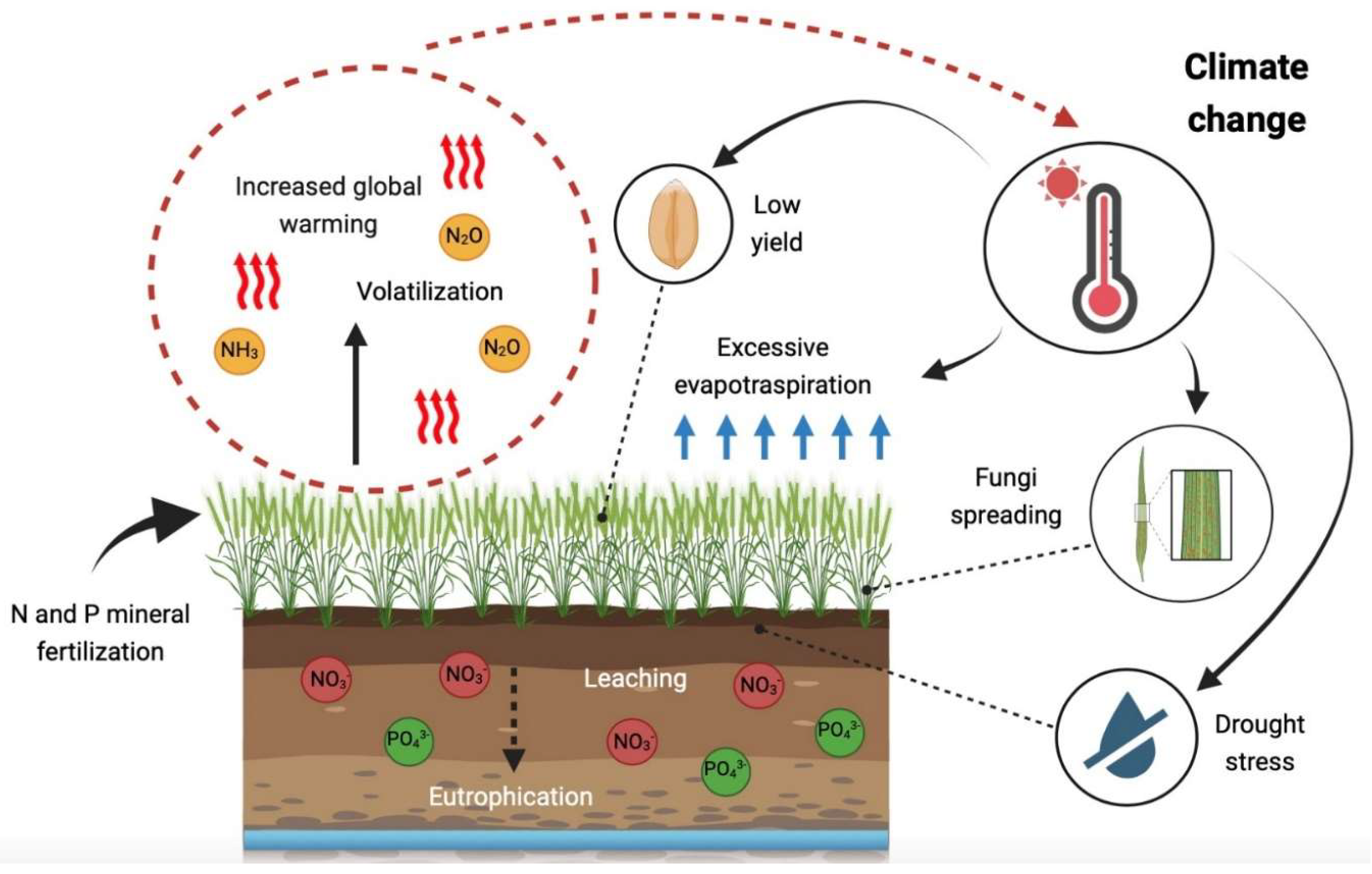
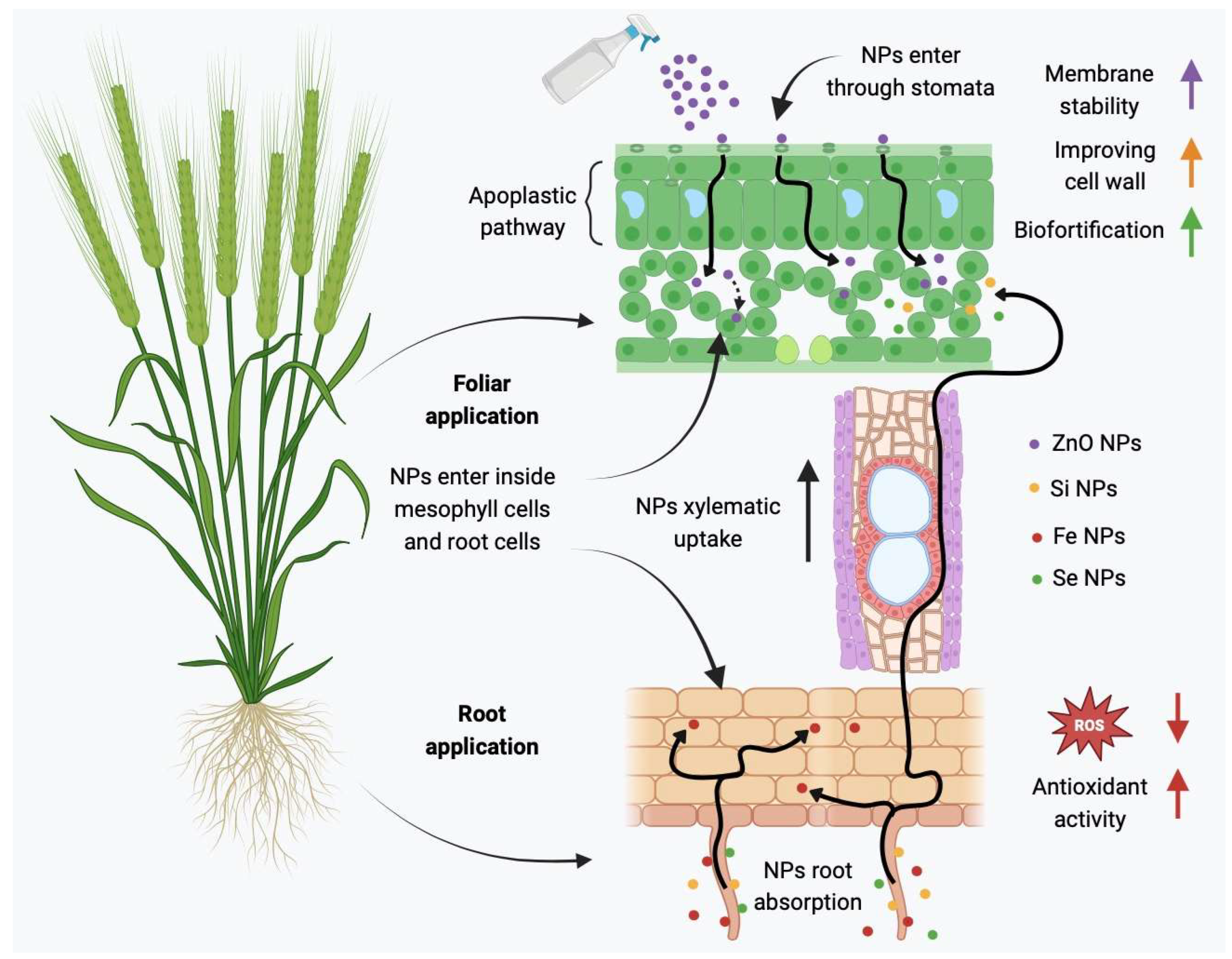
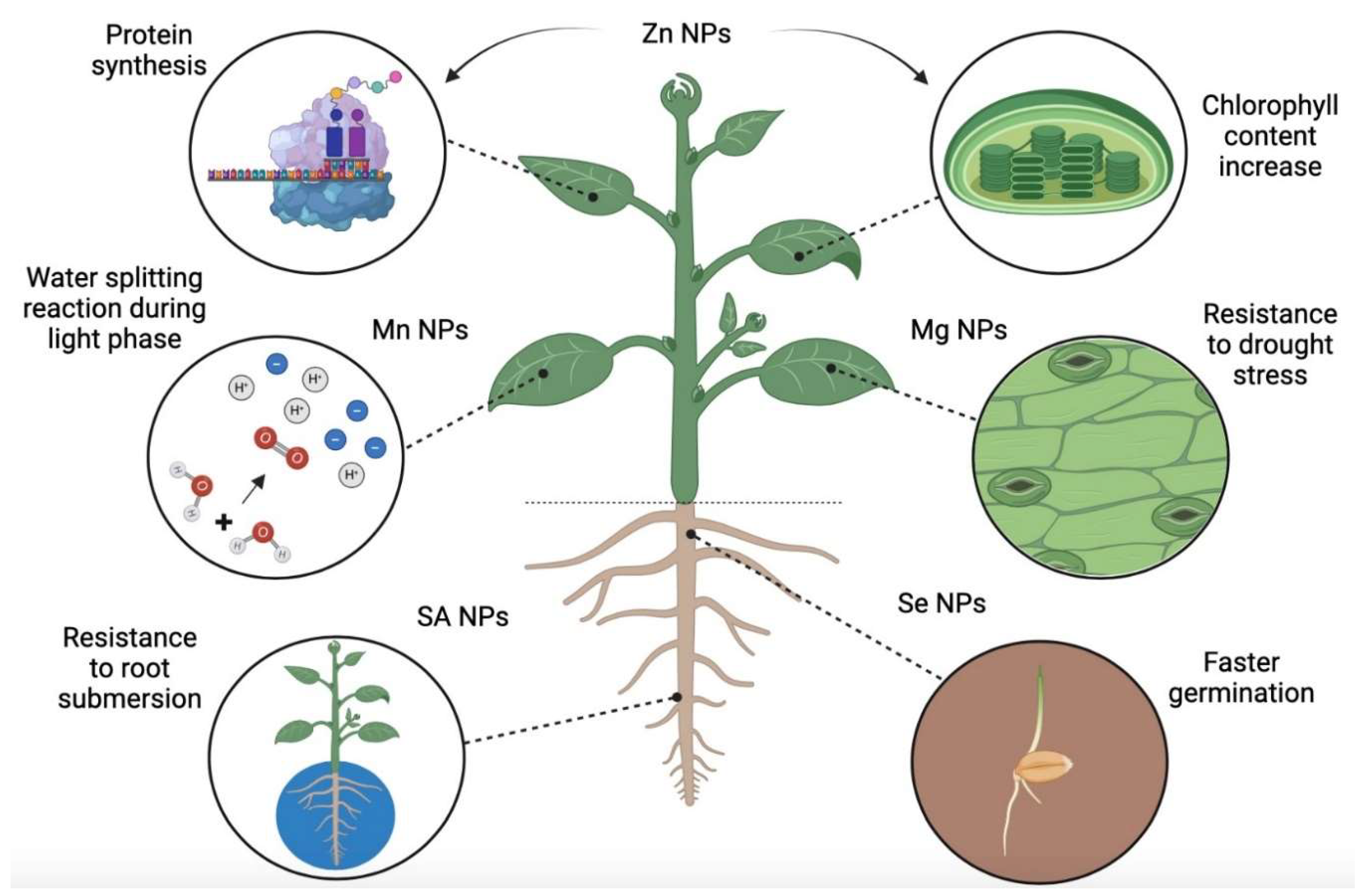
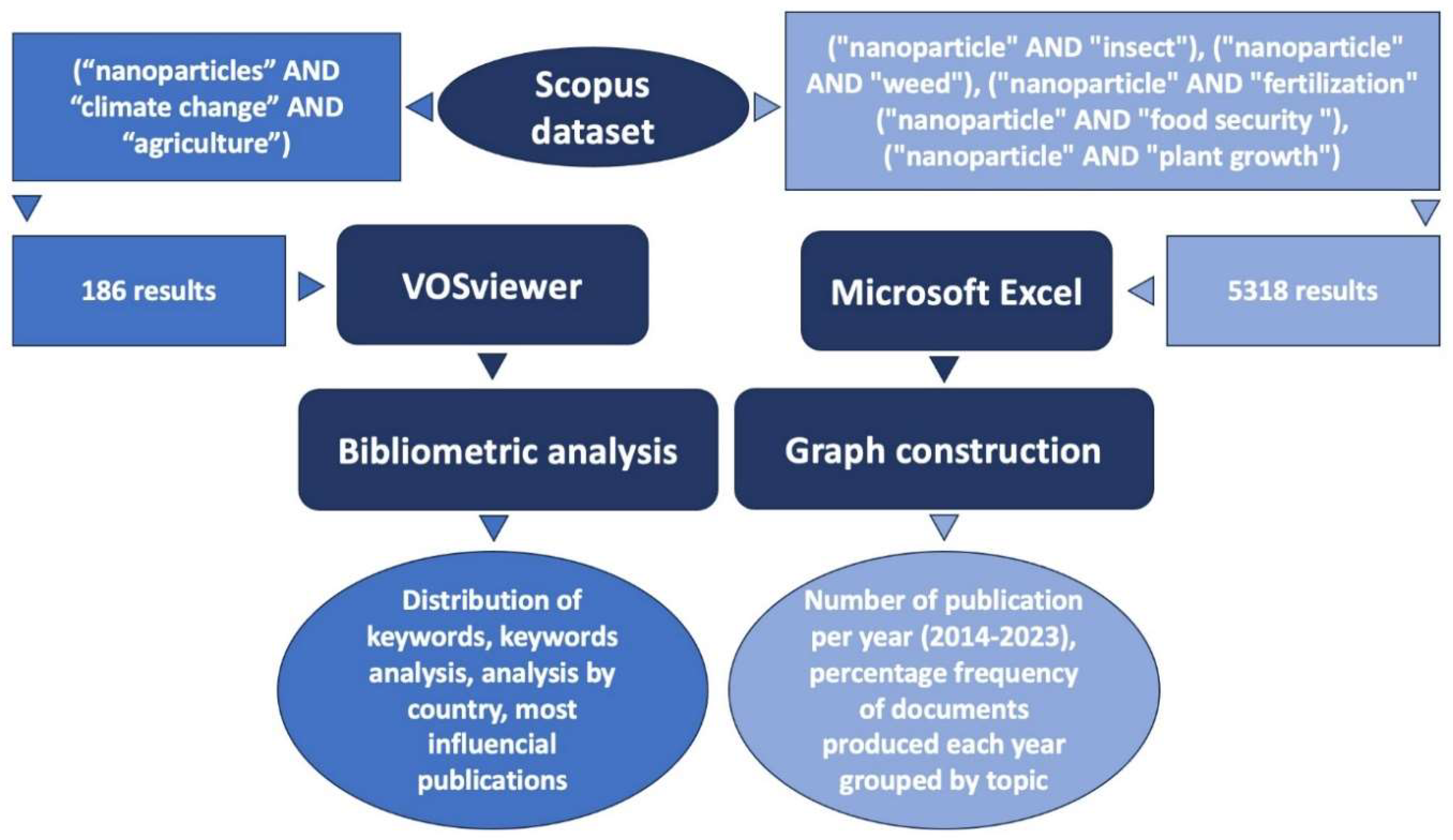
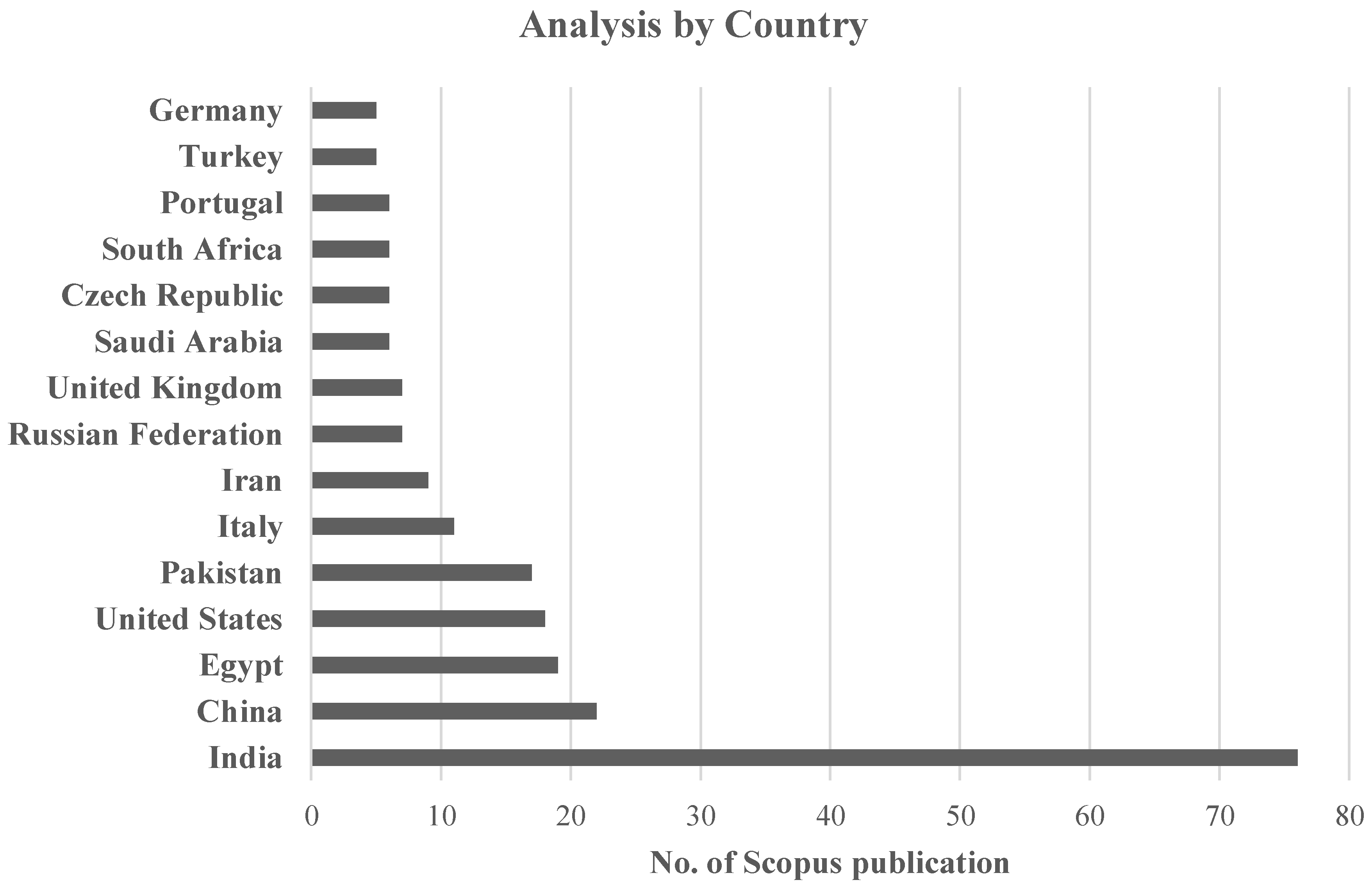
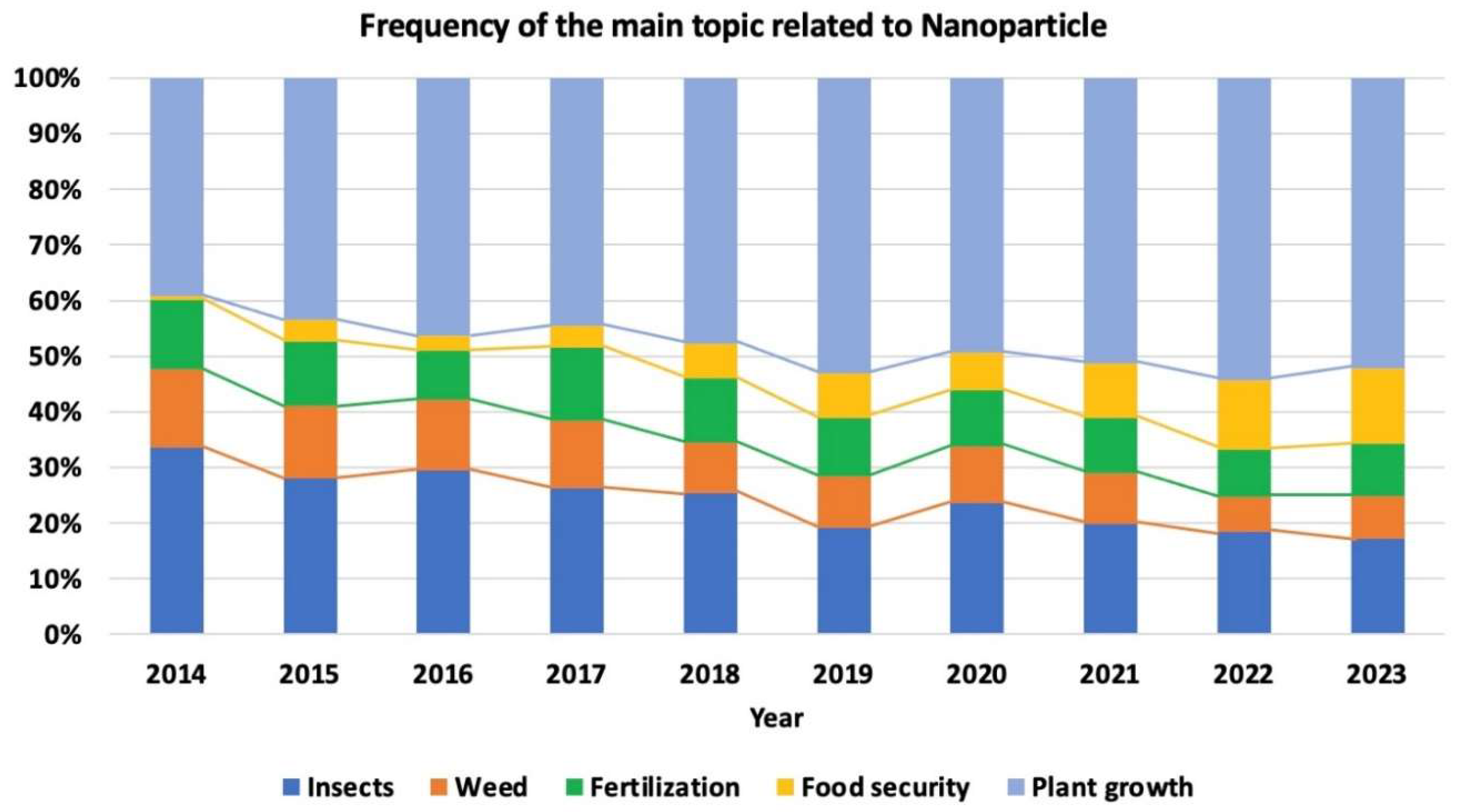
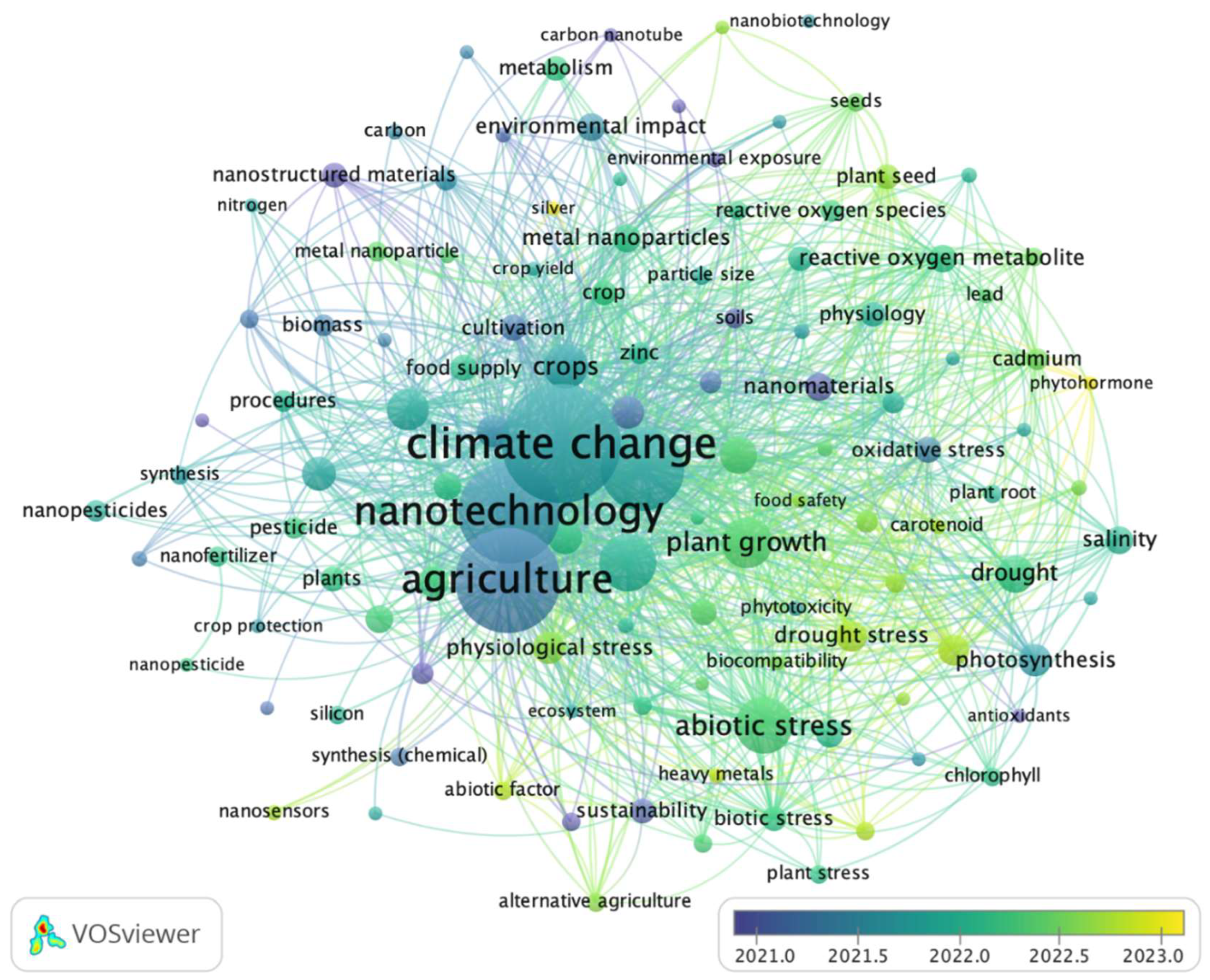
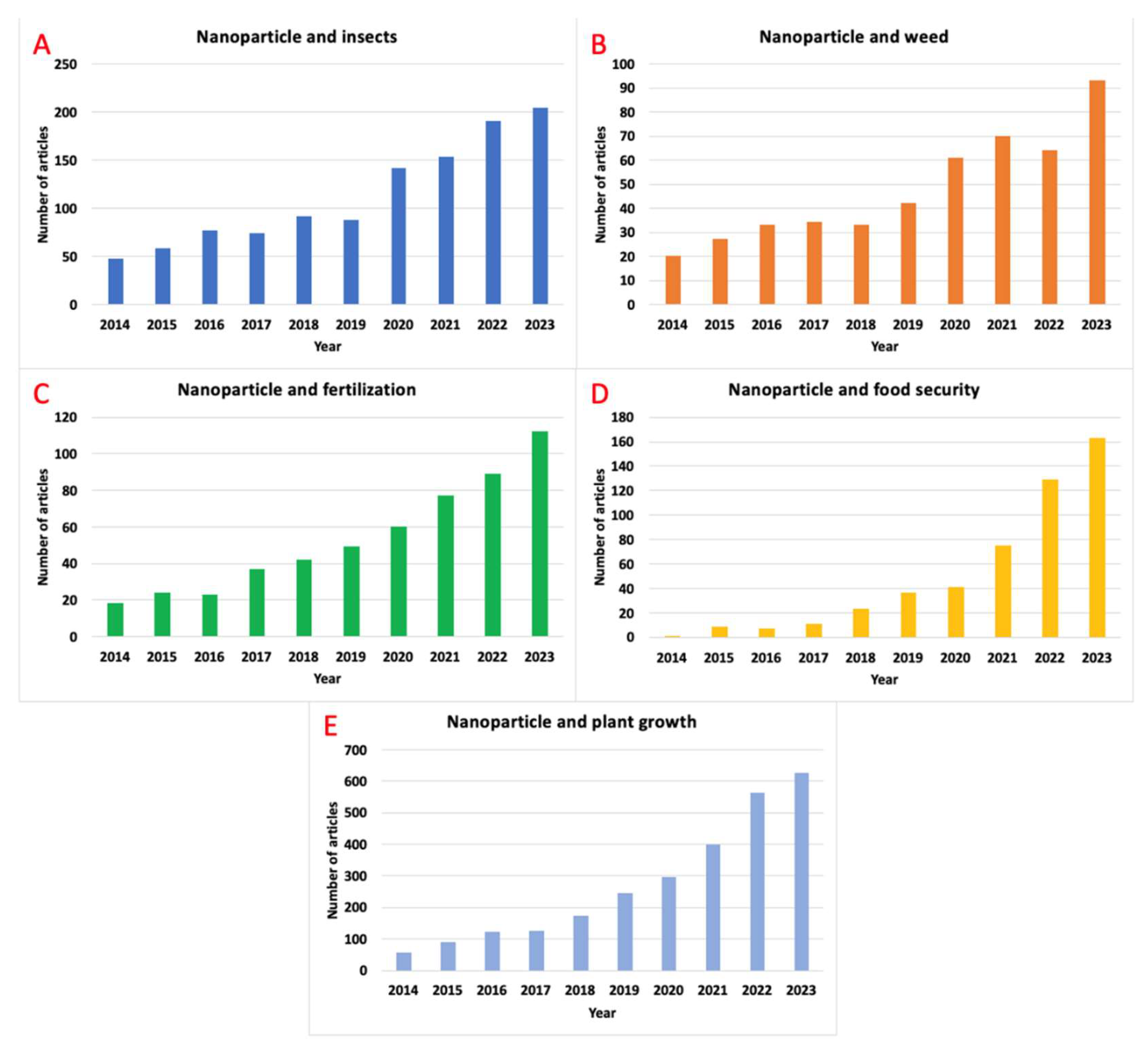
| Category | Nanoparticle | Plant/insect involved |
Function | Ref. |
|---|---|---|---|---|
| Nano herbicide | ZMCPA |
Phaseolus vulgaris |
Vascular growth destruction and chlorophyll content reduction | Johari et al., 2023 |
| Sphagneticola trilobata | Leaves, pigment content and plant height inhibition | Hasrin et al., 2023 | ||
| Ag NP |
Bidens pilosa |
Seed germination and seedling growth arrest | Jiang et al., 2023 | |
| Chitosan NP + (clodinofop propargyl or fenoxaprop-P-ethyl) | Avena fatua and Phalaris minor | Reduced density per m2 and consequently cash crop yield increase | Khan et al., 2023b | |
| Chitosan NP + (mesosulfuron methyl + florasulam + MCPA isooctyl) |
P. minor, A. fatua, Chenopodium album, Lathyrus aphaca, Angalis arvensis and Melilotus indica |
100% mortality | Khan et al., 2023a | |
| Atrazine NP | Brassica juncea | Elevated herbicidal effect | Carvalho et al., 2023 | |
| 2,4-D+biochar nanoformulation | Brassica sp. weed | Growth and biomass reduction | Evy Alice Abigail, 2019 | |
| Encapsulated essential oil | Rhaphanus sativus | Germination, root length and shoot length reduction | Alipour and Saharkhiz, 2016 | |
| SiO2 NP |
Amaranthus retroflexus and Taraxacum officinale |
Sharifi-Rad et al., 2016 | ||
| Nano pesticide | ZnO NP | Puto barberi | Phytophage cuticle dehydration and mortality increase | Agredo-Gomez et al., 2024 |
| Nezara viridula | Reduced attachment to surfaces by mechanisms inhibition | Rebora et al., 2023 | ||
| Spodoptera litura | 100% mortality | Thakur et al., 2022 | ||
| Si NP | Herbivore insects | NP accumulation and digestion inhibition | Bhatnagar et al., 2024 | |
| Fe NP |
Helicoverpa armigera and S. litura |
Antifeeding effect | Muthusamy et al., 2023 | |
| Ag NP | Insect larvae | Cell membrane instability | Shahid et al., 2022 | |
| Chitosan nanocomplex with siRNA | S. frugiperda | Chitin synthesis inhibition |
Gong et al., 2023 | |
|
Nanochitin with Omethoate, Imidacloprid and Acetamiprid |
Rhopalosiphum padi |
Mortality increase | Li et al., 2021 | |
| Pyrethrum extract NP | Apis mellifera | Low concentrations (1 ng µL-1) don’t affect behavior and health | Oliveira et al., 2019 |
| No. | Authors | Title | Source title | Cited by |
|---|---|---|---|---|
| 1 | Tang et al., 2017 | Functionalization of cellulose nanocrystals for advanced applications | Journal of Colloid and Interface Science | 338 |
| 2 | Bahrulolum et al., 2021 | Green synthesis of metal nanoparticles using microorganisms and their application in the agrifood sector | Journal of Nanobiotechnology | 211 |
| 3 | Zia et al., 2021 | Plant survival under drought stress: Implications, adaptive responses, and integrated rhizosphere management strategy for stress mitigation | Microbiological Research | 160 |
| 4 | (Mishra et al., 2017) | Integrated Approach of Agri-nanotechnology: Challenges and Future Trends | Frontiers in Plant Science | 160 |
| 5 | (Pereira et al., 2021) | Nanotechnology Potential in Seed Priming for Sustainable Agriculture | Nanomaterials | 151 |
| 6 | (Avellan et al., 2021) | Critical Review: Role of Inorganic Nanoparticle Properties on Their Foliar Uptake and in Planta Translocation | Environmental Science and Technology | 145 |
| 7 | (Zulfiqar and Ashraf, 2021) | Nanoparticles potentially mediate salt stress tolerance in plants | Plant Physiology and Biochemistry | 128 |
| 8 | (Gilbertson et al., 2020) | Guiding the design space for nanotechnology to advance sustainable crop production | Nature Nanotechnology | 117 |
| 9 | (Shetty et al., 2021) | Aluminum toxicity in plants and its possible mitigation in acid soils by biochar: A review | Science of the Total Environment | 116 |
| 10 | (Sarkar et al., 2015) | Selenium Nanoparticles for Stress-Resilient Fish and Livestock | Nanoscale Research Letters | 116 |
Disclaimer/Publisher’s Note: The statements, opinions and data contained in all publications are solely those of the individual author(s) and contributor(s) and not of MDPI and/or the editor(s). MDPI and/or the editor(s) disclaim responsibility for any injury to people or property resulting from any ideas, methods, instructions or products referred to in the content. |
© 2024 by the authors. Licensee MDPI, Basel, Switzerland. This article is an open access article distributed under the terms and conditions of the Creative Commons Attribution (CC BY) license (http://creativecommons.org/licenses/by/4.0/).





